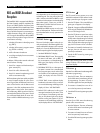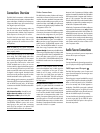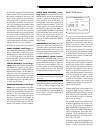
22
RSX-1065 Surround Sound Receiver
Route the wires from the RSX-1065 to the speak-
ers. Leave enough slack so you can move the
components to allow access to the speaker con-
nectors. If you are using banana plugs, con-
nect them to the wires and then plug into the
backs of the binding posts. The collars of the
binding posts should be screwed in all the way
(clockwise). If you are using terminal lugs,
connect them to the wires. If you are attach-
ing bare wires directly to the binding posts,
separate the wire conductors and strip back
the insulation from the end of each conduc-
tor. Be careful not to cut into the wire strands.
Unscrew the binding post collars. Place the
connector lug or the twisted bare wire around
the binding post shaft. Turn the collars clock-
wise to clamp the connector lug or wire firmly
in place.
NOTE
: Be sure that no loose wire strands can
touch adjacent wires or connectors.
RCA Preamp Outputs
There are ten RCA preamp audio outputs:
FRONT (LEFT/ RIGHT), CENTER (1/2), SUR-
ROUND REAR (LEFT/RIGHT), CENTER BACK
(CB1/CB2), and SUBWOOFER (1/2). Use
these outputs to send the RSX-1065’s output
signals to powered speakers or external am-
plifiers used in place of one or more of the
internal amplifiers.
NOTE
: Depending on your system configura-
tion, you may use some or all of these con-
nections. For example, if you only have one
center channel, you would connect it to the
CENTER 1 output. If you only have one cen-
ter back channel, you would connect it to the
CB1 output.
To hook up a powered subwoofer,
connect a standard RCA audio cable from the
SUBWOOFER OUTPUT jack to the input on
the subwoofer’s power amp.
To hook up the RCA main audio out-
puts, connect an audio cable from each
output
to the
input
of the amplifier channel that will
power the corresponding speaker. In a full home
theater system, you will need to make six dif-
ferent connections corresponding to the six
speakers (left front, center front, right front, left
surround, right surround, and subwoofer).
Make sure that you have each output connected
to the correct amplifier channel (front right, left
rear, etc.).
Antenna Connections
The RSX-1065 requires two antennas to receive
radio signals, one for AM and one for FM.
Most users will get acceptable reception us-
ing the indoor antennas which are supplied
with the RSX-1065. Instructions for hooking
up these antennas follow.
NOTE
: If you are some distance from the ra-
dio transmitters, you may use an outdoor an-
tenna to improve reception. Outdoor antenna
systems can be dangerous if they are not prop-
erly grounded and should be installed by a
professional contractor familiar with the elec-
trical code requirements in your local area.
AM Loop Antenna
The RSX-1065 includes a plastic loop antenna
to receive AM radio signals. Remove this
antenna from the box and locate it near the
RSX-1065. It can be tacked to a wall, using
the mounting tab provided. Alternatively, you
can fold the center portion of the antenna to
form a tabletop stand.
Connect the 300 ohm twin-conductor wire from
the loop antenna to the pair of screw termi-
nals labeled AM LOOP, attaching one wire
to each terminal. It does not matter which wire
attaches to which terminal, but make sure that
the connections are solid and that the two wires
do not touch.
You may need to rotate or otherwise reorient
the antenna to find the best position.
NOTE
: To use an outdoor antenna, connect its
300 ohm twin-conductor wire to the termi-
nals in place of the loop antenna.
FM Wire Antenna
The RSX-1065 is supplied with a T-shaped in-
door FM antenna. Connect the attached coax
F-type plug to one of the FM antenna connec-
tors on the RSX-1065. For best reception, un-
fold the T-shaped antenna. Eyelets at both ends
of the T allow tacking the antenna to a wall,
if desired. Experiment with positioning for best
reception.
NOTE
: To use an outdoor antenna, connect its
75 ohm coax lead wire to the FM connector
instead of the indoor wire antenna, only af-
ter a professional contractor has installed the
antenna system in accordance with local elec-
trical codes.
Power and Miscellaneous
Connections
AC Input
Your RSX-1065 is configured at the factory for
the proper AC line voltage in the country where
you purchased it (USA: 115 volts/60Hz AC
or CE: 230 volts /50 Hz AC ). The AC line
configuration is noted on a decal on the back
of your unit.
Plug the supplied cord into the AC INPUT
receptacle on the back of the unit.
See the POWER SWITCH heading in the BASIC
CONTROLS section of this manual for infor-
mation about turning the unit on and off.
NOTE
: Memorized settings and video labels
will be stored for up to one month if the
RSX-1065 is disconnected from AC power.
Accessory Power Outlets
(North American version)
The RSX-1065 has two switched outlets on the
back panel. Power is available from these
outlets when the RSX-1065 is turned on. These
outlets can provide up to a total of 200 watts.
They are appropriate for supplying power to
signal sources, such as CD players, tuners, or
tape decks. They should not be used for power
amplifiers. Connecting components that will
draw more than 200 watts to these outputs
could damage the RSX-1065.
12V TRIGGER Connections
Several Rotel amplifiers offer the option of
turning them on and off using a 12 volt trig-
ger signal. These two connections provide this
12 volt trigger signal. When the RSX-1065 is
activated, a 12 volt DC signal appears at these
connectors and will turn on amplifiers. When
the RSX-1065 is put in STANDBY mode, the
trigger signal is interrupted and the amplifi-
ers will turn off.


















